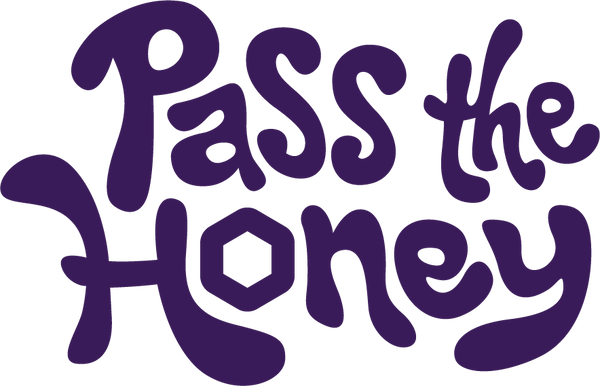Pass the Honey supports beekeepers and landowners - particularly those who own and work on agricultural lands - to manage land and grow food in a way that provides honeybees and other important pollinators with healthy, uncontaminated forage.
Considering the prevalence of chemicals in the world’s landscapes, our standards require that beekeepers establish such areas, but does not require that land to be certified as organic. [link to regenerative v organic]We cannot ensure a honeybee will never visit a faraway field that has been sprayed with pesticides. We can, however, test honey consistently to ensure any residue levels fall well below USDA thresholds for human consumption. Testing also gives us the opportunity to identify contamination and work with producers to eliminate those sources of contamination.
Through Pass the Honey, our intention is to bring a new level of support for beekeepers using regenerative approaches and provide consumers with a higher level of product transparency and authenticity.
In order to provide consumers with this higher level of product transparency and authenticity that upholds our regenerative practices, we adhere to strict testing requirements. These tests are run by third party laboratories using Liquid Chromatography Mass Spectrometry (LC-MS) and Nuclear Magnetic Resonance (NMR) testing.
The NMR tests for any level of honey adulteration and shows if honey has been mixed with other syrups, diluted, overheated, contains sugar syrups fed to bees, or harvested early - before the honey has had time to mature.
LC-MS tests for the presence of specific pesticides, herbicides, fungicides, vet drugs, and other contaminants that have the possibility of bioaccumulating in the honey or wax.
Pass the Honey tests honey for contaminants specifically identified by the EPA’s database of food contaminants for honey and honeycomb, including Tau-Fluvalinate, Coumaphos, and Amitraz – all extremely powerful, toxic miticides most commonly used to control pests and disease within honeybee colonies. In the absence of a maximum threshold for honeycomb, the levels for liquid honey will be used.
LC-MS is also used to identify significant sources of contamination that are not included in specific USDA pesticide and vet drug panels. In the case a contaminant is found and not listed in the USDA database for honey or honeycomb, the lab will use EPA standards and thresholds for similar food matrices such as chicken eggs.
Due to the limited contaminants included in the EPA’s database specifically for honey, the lab also tests for additional contaminants, a total of 300 pesticides including glyphosate, which we threshold action levels at 3.5 ppm. Action level refers that we contact the client as to the level in the honey. Our Limit of Quantification (LOQ) is 0.5 ppb, so we can detect whatever the organic threshold is requested.
Pass the Honey currently uses the maximum residue levels for all contaminants as established by the EPA as our official Maximum Residue Levels. However, we have not yet seen any of our suppliers' honey levels even close to threshold.
We pride ourselves on establishing strict standards and commitments in regenerative apiculture to ensure that our regenerative supply is always authentic.
All products purchased by Pass the Honey must adhere to the following testing requirements:
- Magnetic Nuclear Resonance (MNR) test results with no direct adulteration by: syrups, dilution, ultrafiltration, and heating.
- MNR test results with no indirect adulteration by: feeding of sugar water, syrups or other nectar substitutes, to honeybees during harvest or early harvesting.
- No contamination from antibiotics, pesticides, herbicides, fungicides and other industrial contaminants above maximum residue thresholds established by the USDA.
- Pollen test confirms the authenticity of origin.
Test results showing any adulteration or contamination levels above approved thresholds will result in Pass the Honey rejecting the product. It is also important to mention that we conduct initial testing on all new suppliers and frequent randomized testing prior to allowing any of our honey to make it into the consumers hand.
Pass the Honey is built on the foundation of developing trusted and transparent procurement and logistics in order to catalyze system-wide impacts. Chain-of-Custody and Proof of Cleanliness (unadulterated/uncontaminated) technologies in particular are critical to incorporating transparency and authenticity, and eliminating widespread fraud.
It is becoming more feasible to implement industry-wide changes through the work of labels such as Genu-Honey and labs like Sweetwater Science Labs focused on food authenticity testing methods and standards that directly address the needs for Proof of Cleanliness. The increased understanding of practical applications of blockchain technologies for Chain-of-Custody and traceability throughout the supply system will enable consumers to not only have clear Proof of Cleanliness but also connect more deeply to the story of the beekeeper and impacts of the honey from bee to kitchen.
Brands have an important role to play in investing in regenerative apiculture systems and educating consumers. Outside of direct sales to consumers, brands are the bridge between beekeepers and the end consumer. Today’s US consumers are becoming more conscious about where their food comes from and interested in supporting food that is produced in a way that improves ecological and social resources. Pass the Honey is working at the forefront of this interest.

